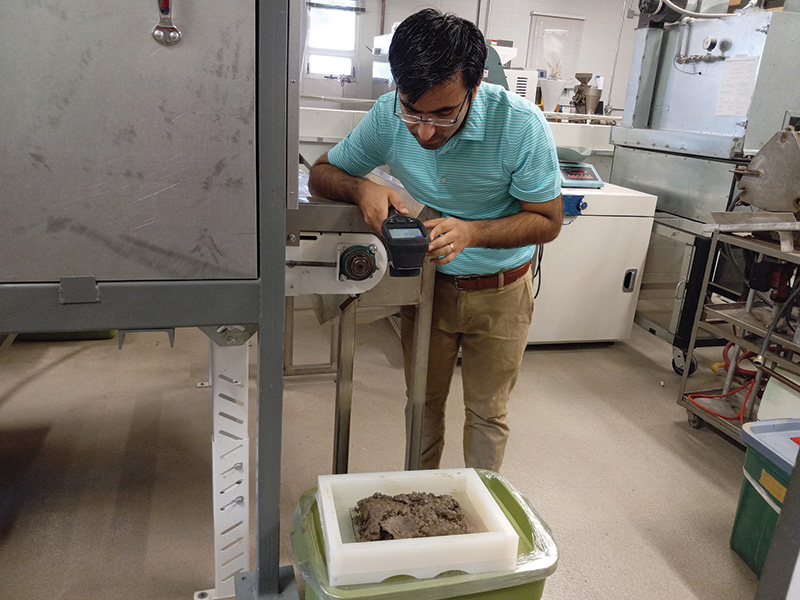
Kaushik Luthra uses an infrared camera to measure the soil surface temperature profile just after microwave treatment. Photo courtesy of Kaushik Luthra/University of Arkansas System Division of Agriculture
It’s a magical machine that can bring new life to a cooled-off cup of coffee in just 30 seconds on a frosty morning. We’re talking about a microwave, of course, and researchers in Arkansas are gearing up to add yet another function to this handy device: weed-seed zapper.
Scientists at the University of Arkansas’ Agricultural Experiment Station are conducting experiments that may lead to microwave technology that can zap weed seeds underground before they have a chance to sprout and ruin an otherwise impeccable stand of newly sprigged, seeded or sodded turfgrass.
Initial research has been aimed at weed-seed reduction in the production of cotton and rice, important crops for Arkansas farmers.
A new study is being funded by an almost $300,000 Agriculture and Food Research Initiative grant from the U.S. Department of Agriculture’s National Institute of Food and Agriculture, with additional support from The Cotton Board and Cotton Inc.
“Even if we can reduce the seed bank by only 50%, that would be a lot because the reduction in weed density would greatly increase the efficacy of herbicides and eventually reduce herbicide use,” says Nilda Burgos, University of Arkansas professor of weed physiology and molecular biology and principal investigator of the study. “It will be another tool for integrated weed management that is sustainable and nonchemical.”
Using a low-frequency microwave set at 915 megahertz, rather than the typical home microwave that operates at 2,450 MHz, researchers can reach more deeply into the soil in pursuit of buried seeds. For turfgrass, that may mean treating the soil on a green or fairway before laying sod, sprigging or seeding.
Preliminary studies using low-frequency microwaves fully inactivated seeds from weedy rice at 3.5 inches underground and reached most weed seeds as deep as 6 inches. While seeds were eliminated, beneficial microbes recovered quickly after the treatment.
Those studies were conducted by Kaushik Luthra, food science post-doctoral fellow, and Griffiths Atungulu, associate professor and agricultural engineer for grain processing and post-harvest system engineer.
Burgos’ new, two-year study is focused on 10 weeds, including broadleaf weeds Palmer pigweed, prickly sida, common lambsquarter, ivyleaf morning glory, common ragweed and spurred anoda, as well as grass weeds, including barnyard grass, goosegrass, Texas panicum and Italian ryegrass. The study also will evaluate the effectiveness of a plant growth regulator on herbicide activity aimed at reducing weed fertility and seed germination. In addition, researchers will examine the effect of soil adjuvants on herbicide residual activity on fall-planted crops.
“There is significant potential for applying this technology to golf course weed management,” Atungulu says. “Selective treatments can be achieved by adjusting the energy and duration of microwave application.”
Burgos agrees with the turfgrass potential.
“The technology is applicable to areas being prepared for seeding turfgrass or before laying down sod,” Burgos says. “For established turfgrasses, experiments have to be conducted on turfgrass on putting greens, a common species used on fairways and on a common species used on the rough to determine the tolerance of these species to the microwave energy used to kill weed seeds.”
She envisions two timings: during active growth and during dormancy: “My hypothesis is that species’ tolerance differs; dormant grass will not be affected (as with herbicide application); and the same microwave energy can penetrate deeper in putting greens, where the soil is primarily sandy, than in soils with more clay content.”
She hopes to secure funding to add such applications to the project.
The study will enable researchers to investigate the use of microwaves on various soil types and soil depths, gaining an understanding of how microwave energy performs within contrasting soil properties, Burgos says.
How will technology go from the lab to the field? The team envisions using a tractor’s power takeoff shaft as the energy source to power a microwave implement. The previous studies required 30 kilowatts to achieve maximum seed destruction, which can be generated by the engines in most farm tractors. Atungulu is seeking funds to build a prototype.
So, the next time you give your cup of Joe a little microwave boost, imagine a day when you can use the same technology to clear a path for weed-free turf. And we’re not talking about a 30-second warmup. When it comes to weed seed eradication, we may be looking at a full-power, baked-potato setting. No mercy.
Darrell J. Pehr is GCM’s science editor.